Russia has successfully launched 2 European satellites
The Russian "Rokot" boosters on November 2 were launched from the northern Plesetsk space airport, in the north of the country, bringing two European space devices, including satellites to observe Earth SMOS and test equipment. Proba-2 technology on orbit.

SMOS (Soil Moisture and Ocean Salinity) is the second satellite built by the European Space Agency (ESA) in the "Living Planet" program. The satellites SMOS used to monitor at the global level 2 parameters affecting the weather and climate are soil moisture and salt concentrations of the oceans.
ESA says that satellites can detect changes in salt concentrations of 0.1 g salt per liter of water and soil moisture at a level of one teaspoon on a handful of soil.
Data from SMOS will complement the missing information on global level changes in soil moisture content and salt concentration of the oceans, further understanding the water circulation on Earth, thereby building the more complete climate models as well as increased accuracy for weather forecasts.
According to ESA, data on global circulation of moisture on Earth will help ecologists better understand the processes that lead to climate change as well as predict the occurrence of temporal conditions. Extreme weather, or places where storms may occur.
SMOS has a mass of 658kg, operating in a high orbit of 760km, a 3-year shelf life and can last for another 2 years.
Proba-2 satellites used to test the effectiveness of new space technologies will then be used to make future space devices.
It is expected that the satellite will test new technology products and perform four scientific experiments to monitor the Sun and weather from the universe. The satellite weighs 130kg, operating at a high orbit of 800km with a 2-year use period.
- Russia successfully launched the European telecommunications satellite
- Europe has successfully launched two telecommunications satellites
- Russia successfully launched 9 satellites
- Russia successfully launched 11 satellites from Vostochny space airport
- Europe successfully launched two telecommunications satellites
- Russia successfully launched a military satellite
- India successfully launched seven satellites into orbit
- Russia successfully launched the Dutch telecommunications satellite
- EU successfully launched missiles carrying two Galileo positioning satellites
- Russia launched 6 American satellites
- Russia launched three military satellites into orbit
- Nigeria successfully launched two observation satellites
 Van Allen's belt and evidence that the Apollo 11 mission to the Moon was myth
Van Allen's belt and evidence that the Apollo 11 mission to the Moon was myth The levels of civilization in the universe (Kardashev scale)
The levels of civilization in the universe (Kardashev scale) Today Mars, the sun and the Earth are aligned
Today Mars, the sun and the Earth are aligned The Amazon owner announced a secret plan to build a space base for thousands of people
The Amazon owner announced a secret plan to build a space base for thousands of people 'Strange smell' detected on cargo spacecraft to ISS
'Strange smell' detected on cargo spacecraft to ISS  After 4 years of being sent into space by Elon Musk, what is the fate of the $100,000 Tesla Roadster now?
After 4 years of being sent into space by Elon Musk, what is the fate of the $100,000 Tesla Roadster now?  The Shape of the Universe Isn't What You Think: From Ancient Round Sky to Modern Three-Dimensional Donut
The Shape of the Universe Isn't What You Think: From Ancient Round Sky to Modern Three-Dimensional Donut  How to get back to the spacecraft if the astronauts leave the cabin to work and accidentally drift away?
How to get back to the spacecraft if the astronauts leave the cabin to work and accidentally drift away?  Announcement of discovery of micro-asteroid population in the Solar System
Announcement of discovery of micro-asteroid population in the Solar System  Solving 'traffic jams' in space
Solving 'traffic jams' in space 